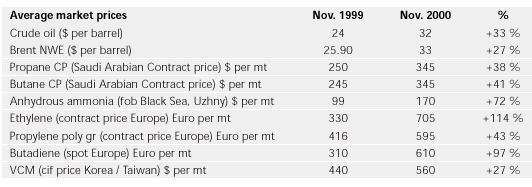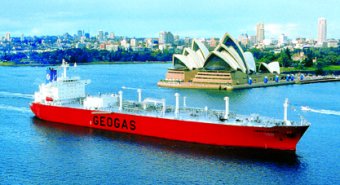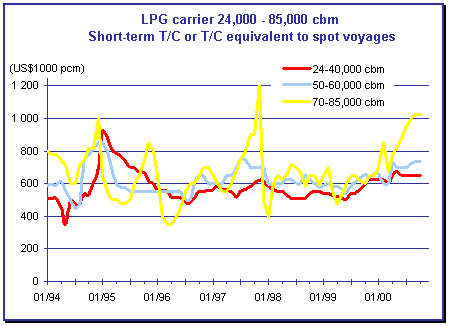
The LPG shipping market
in 2000 |
|
|
| |
| Global rise in commodity prices and freight markets
|

|
|
Whilst the predominant market features of the two
previous years were mergers and fleet concentration, we could describe
2000 as the year of a quasi regular state of firmer prices for most
petroleum products and, to a lesser extent, a gradual rise in freight
levels on all LPG tonnage segments, although more limited as compared to
the oil tanker markets.
We may illustrate this situation with the following
reported price quotations for the main product segments in oil, LPG and
the petrochemical gas commodity markets, '

' and with the following average freight rates
basis spot voyage or average short-term time- charter equivalents for
main categories of LPG carriers (such figures exclude idle time between
cargoes or time-charter trading periods).

Obviously sporadic moves, up and down, took place all
along the year in the various size categories, as is usually the case
when spot or short term markets are considered, but the average trend
has been gradually improving until the last quarter of 2000.
Different factors led to this strengthening in
freight rates, which we were intimating in our last year's annual
report, among these, the following could be highlighted :
- A healthier economy worldwide: the World Bank and the OCDE report
a world GDP growth rise of 4 to 4.5 %, whilst world trade has gone
up by 12.5 % over the year 2000.
- A global increase of oil demand facing Opec regulating moves and
quota restraints, resulting into firmer oil and products prices,
thereby opening new arbitrage margins.
- The combined effects of recent mergers among oil and petrochemical
"Majors", and consolidation moves which took place over
the past two years among shipowners operating LPG carriers of sizes
above 8,000 cbm.
- A continued development of long-haul voyages with increased
volumes on new shipping routes where the price volatility of main
gas commodities such as LPG, ammonia and chemical gases allows for
temporary imbalances between supply and demand and arbitrage
positions.
- A stringent control and supervision of vessels' quality on
traffic between industrialised producing and consuming areas,
although such control has been in force for gas carriers for a long
time.
- An overall restraint on behalf of shipowners for fleet expansion
which has been rather limited since the Asian crisis in mid 1997
until 2000, especially for fully and semi-refrigerated types of
tonnage.
The combined timing of the above various factors has contributed to
the strengthening of the market and the upturn of freight earnings.
|
| Highlights over the year |

|
- The 'Erika' effect, which we cannot ignore, although being
more psychological than factual for gas ships. Indeed, gas ships,
naturally double-hull, have been closely followed and checked
through vetting organisations well before a similar vetting system
was adopted for oil tankers. Furthermore, the nature of the gas
commodity transported, with a lower degree of stress and corrosion,
helps to explains why no major casualty has ever occurred on gas
carriers, even on old ships. Let it be this way for many years ahead
!
- Shipowners' consolidation moves resulted in a double-edged
freight situation: firmer spot freight levels as opposed to trading
equivalent freights on the larger size ships, depending on whether
the vessel is "pool controlled" or "not".
- Idle time, which used to be accidental and a misfortune for
owners, has turned out to be a tactical element of owners approach
to the freight market.
- LPG "Majors" or traders increased share of the
commercial control on ships, whether it be through longer term
time-charter commitments or purely ownership control. This kind of
development is a an old story in shipping and more particularly in
the LPG industry where trying to find the best balance between
long-term financial commitment and short-term coverage with more
exposure to market fluctuations can be a difficult task on a
restricted market.
- Increased volumes of gas chemical movements partly due, as usual,
to unexpected outages or planned turnarounds, mainly on the ethylene
front. A general shortage of molecules in Europe and a strong demand
in the USA linked with competitive prices in South East Asia,
contributed to a solid rebound of the ethylene, propylene and
butadiene markets.
- Newbuilding prices which heavily decreased during the last two
years (up to 30 %) have recently fuelled new orders from shipowners
and "Majors", more influenced by bottom line prices than
by additional tonnage requirements.
One should also note the continued interest of
Japanese owners placing orders in domestic yards for pressure-type LPG
carriers of sizes between 4,000 and 7,500 cbm, for delivery end-2001 /
end-2002, and fixed out for time-charter periods of up to five years
plus options. Such moves are partly due to the prevailing financing
conditions obtainable in Japan at very low interest rates.
 |
ANNE LAURE
78,000 cum fully-ref., blt 2000 by Daewoo - Commissioned by her owner Geogas
Shipping - seen passing Sydney Bay. |
|
| Situation by Ship segments:
|
|
- VLGC (very large gas carriers): 70,000 to 86,000 cbm
|

|
|
This is "the" specific size of LPG
carriers, which always had and still has its own identity and direction
within the LPG industry. Whether it is because this size represents some
70 % of the total LPG carried in the world, with a major share being
controlled by one single Norwegian owner, or because trading such LPG
vessels is closely linked to product prices fluctuations, can be a long
debate. Still the VLGC market has its own logic !
2000 was a year of mixed results for shipowners.
Whilst the spot freight on the traditional benchmark route Middle East
Gulf / Far East increased from $27 per mt in November 1999 to $42 per mt
by November 2000 (which represents a time charter equivalent of some
$1.1 million), an increased percentage of idle time of up to 20 % has
dramatically affected this segment and particularly Bergesen who
controls a large part of this market, mainly on a fully-owned basis with
a few units pooled. Such idle time has lowered the net fleet earnings
per ship down to circa $575,000 monthly.
However, the situation improved towards the end of
the year when the alternative employment of CPP (naphtha and
occasionally jet fuel) was frequently open to generate a time-charter
equivalent in excess $1.5 million monthly. This latest development is
however directly linked to the oil tanker supply and the versatile CPP
market which has recently reached peak levels.
The time-charter market has been reasonably active at
levels reaching an average of $850,000 for a 12 to 18-month period.
On the newbuilding side, eight more units of 78,000 /
82,000 cbm have been ordered since January 2000 for delivery between
early 2002 and 2004, while five ships have been delivered during the
same period. Together with the orders confirmed prior to January 2000,
this makes a total of 14 ships on order out of which seven ships will be
delivered in 2001.
Although this size segment still suffers from
over-capacity, such orders can be partly explained by LPG producers'
endeavours to control their own tonnage at newbuilding price conditions
near bottom levels.

|
|
|

|
|
This ship class has achieved much better results than
last year, generated by the expansion of NH3 long-haul voyages from the
Black Sea to the USA and the Far East, plus alternative opportunities in
the CPP and naphtha markets and the impact of firmer markets in the
larger and lower tonnage size segments.
Depending on size, age and specifications, monthly
average returns reached $750,000, a 15 % increase over last year's
levels. Such an upturn was however limited here as well, by idle time.
No newbuilding order was reported within this segment and only one
52,000 cbm built in 1971 was sold to demolition.
|
|
|

|
|
Mainly supported by a substantial strengthening of
the ammonia market, this highly consolidated sector has registered the
sharpest increase in freight level, up to 50 % on spot rates in some
specific areas. This situation and the concentration of tonnage has led
a few charterers and traders to further cover their shipping
requirements through medium or long-term periods, sometimes up to three
or five years.
However, the overall earnings of shipowners did not
increase in the same proportion due to a repetitive idle-time averaging
14 % over the year.
Stringent quality restrictions on the LPG trade
pushed a few older units to switch from LPG to NH3 on a permanent basis,
where old upgraded ships but in good conditions are still qualified by
several terminal operators. New orders were limited to two 35,000 cbm
vessels for the account of Bibby Line and Geogas, both for delivery end
2002 at Korean yards.
|
Shipping and Shipbuilding Markets in 2000
I N D E X
|